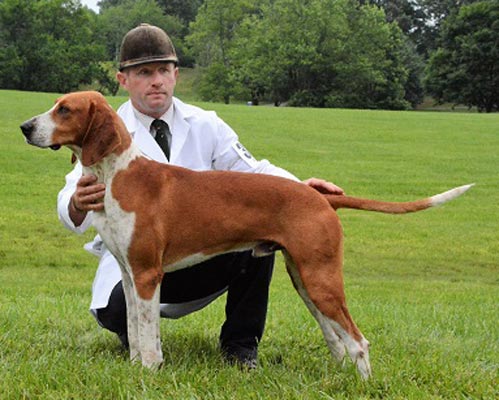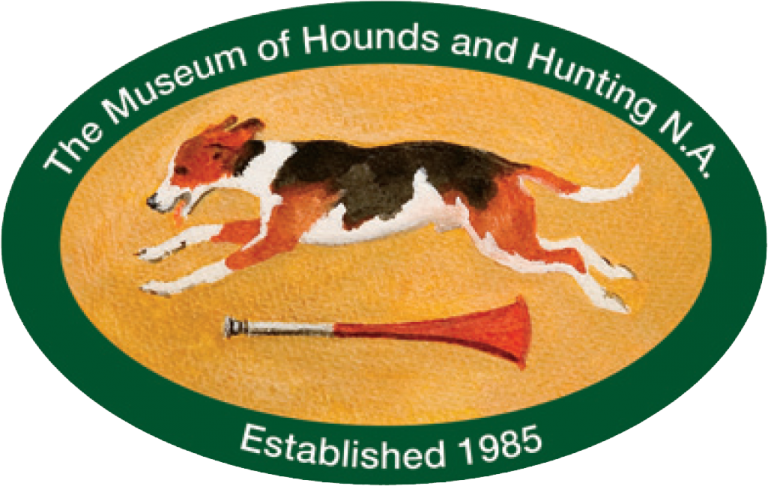Kermit is a big, exuberant dog who aims to please. The hound is playful—he jumps around a lot, and wags his tail. He’s observant with watchful eyes and, in the presence of his master, Orange County Huntsman Reg Spreadborough, obedient.

“He’s probably the finest American foxhound I have ever seen.” said Martin Wood, MFH of the Live Oaks Hounds and one of the most foremost hound judges in the country. Wood pinned Kermit Grand Champion Foxhound at the prestigious Bryn Mawr Hound show this past June. A week earlier ex-MFH John J. Carle III of Keswick saw Kermit receive the Champion American Fox Hound distinction at the Virginia Hound Show at Morven Park, marked by the William W. Brainard, Jr. Perpetual Cup.
Admirers wax profane. “He’s a magnificent dog with a gymnast’s body, with a flawless shoulder and a generous elbow slash that facilitates his awesome, effortless stride,” writes Carle. “He’s got tremendous power, he’s got wonderful quality and balance, and he moves well,” echoed Wood. “I kind of felt sorry for the other competitors at Bryn Mawr.” They didn’t stand a chance, he said, against “absolutely the best-American dog-hound I have ever seen.”
Kermit is handsome, with white markings against a chestnut base—the distinguishing feature of an Orange County red ring-neck hound. His nose and the last four inches of his tail are white, and he sports a white “shawl” around his neck and chest. Muscles articulate his back, with powerful hind legs supporting his robust frame. When he moves, however, limbs move effortlessly as he lopes along. As he runs his back legs, in their reach, almost go beyond the footfall of the front ones.
Frankly, though, to an untrained eye, Kermit looks like other Orange County Hounds—floppy ears, exuberant movement, and white markings against a chestnut or “red” body. So how does a judge select the best foxhound? Does he or she look for a certain conformation, or is it the way a hound moves? Does a judge consider a hound’s performance with others in a pack? What role does a good “nose” play?
Spreadborough says at the shows, it’s hard to know which hounds will pin and that often a judge’s decision seems arbitrary — though admittedly, Kermit might be the exception, given his large size and extravagant movement. As for his hunting style, Spreadborough said, “he’s in the middle of the pack. He does his job.” His conformation, movement, and presence, however, set him apart in the ring. “When Kermit stands up in competition, he exudes all the qualities I want to see in a mature dog-hound-stallion hound,” said Wood.
Spreadborough bred Kermit and his get. He joined forces with Potomac Hunt’s huntsman Larry Pitts, and mated Orange County bitch Pernod 2011 to Potomac Kadillac, a dog from the the prestigious Potomac Jefferson ’05 bloodline. Jefferson, renowned for his own balance and movement, took the grand foxhound championship at the Virginia and Bryn Mawr shows in 2007.
The Jefferson and now Kermit line throws winners. OCH bitches Juicy and Jury (Kermit-Their Justice) won competitions at Bryn Mawr, as did their brothers Junior and Judo, who won the “couple of dogs unentered” class.
OCH master John Coles says Spreadborough deserves a lot of credit. “He’s bred a wonderful pack of hounds — a great hunting and show pack. He works hard on the hounds and they all look great,” he said.
Wood, too, sang Spreadborough’s praises as he explained what he looks for when he’s judging hounds—be they American like those of OCH, or crossbreds and English, like those of his Live Oak Hounds in Monticello, Florida. “My judging criteria can be summed up in three points—quality, balance (pace & endurance), and activity. Quality is the overall impression that I get of a hound when I first see him in the ring and he’s perhaps trotting alongside his handler just going around the outside of the ring before I call him up. It’s something a hound exudes, and he’s either got it or he doesn’t,” he said.
Balance is just that — are the hindquarters level when you view them from behind? Does the hound stand squarely on all four feet? From the front, are the shoulders even? “What you want is a nice head going into a nicely-sloping neck into good strong but sloping shoulders which allows him to have the strike that he needs,” said Wood. “You want a good depth to his heart and lung area. And generally I assess that by looking at the elbow of the hound; if the ribcage extends just to the elbow, it’s good.”
To huntsman Hugh J. Robards, MFH, author of the Derrydale Press book Foxhunting (2006), conformation is key. “A hound that is built physically correct will be able to continue hunting longer than one that has faults. As a result, that hound will become more experienced in hunting the fox on different scenting days, thereby gaining fox sense and, hopefully, passing that sense on to some of the younger hounds,” he wrote.
But it’s Kermit’s lope that astounds. Carle compared Kermit’s “powerful and polished” performance to that of the dancer Baryshnikov. “He is the picture of power wedded to grace; and when he moves, everything is as in-concert as the workings of a fine Swiss watch,” he wrote recently.
Wood echoed this sentiment. “One of the great beauties of a foxhound is the quality of movement. It’s almost poetry in motion because they are designed to run farther and faster than the quarry and keep it up for miles,” he said. The way Kermit reaches out in stride makes him fast and beautiful to watch.
Melvin Poe, OCH huntsman for almost thirty years, believed how a hound moves tops the list of its credentials. “Like horses that move well, the hounds will last a lot longer if they’re good movers,” he said to Peter Winants, author of the biography Foxhunting with Melvin Poe. Because hounds have to overtake quarry and run for a long time, effortless speed coupled with endurance is essential. And OCH’s Kermit’s got it all: conformation, movement, and an ethereal grace that keep all eyes glued to him.


